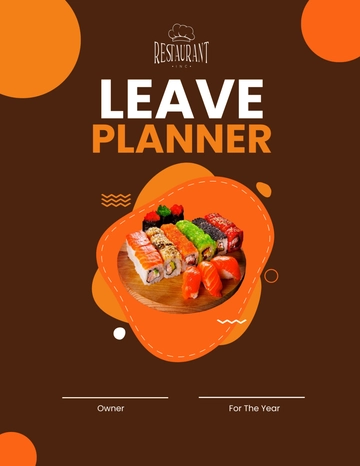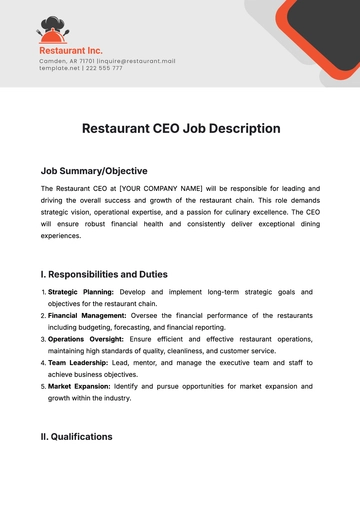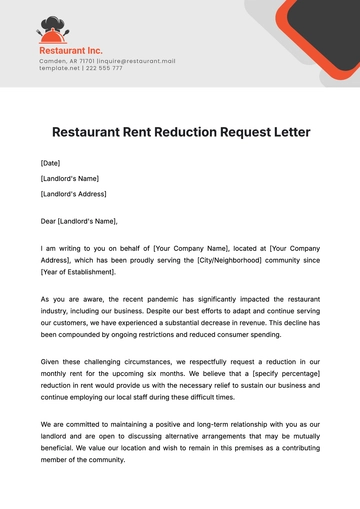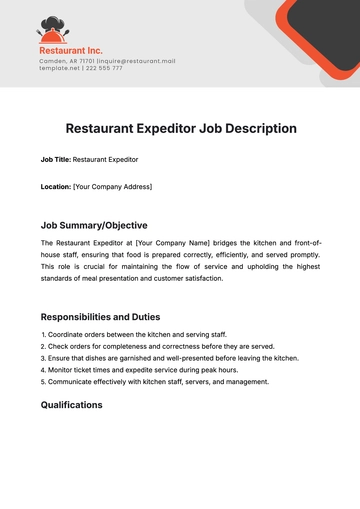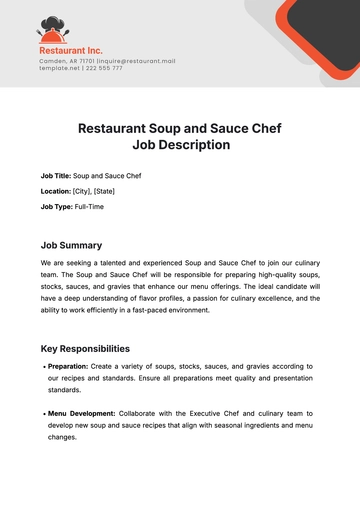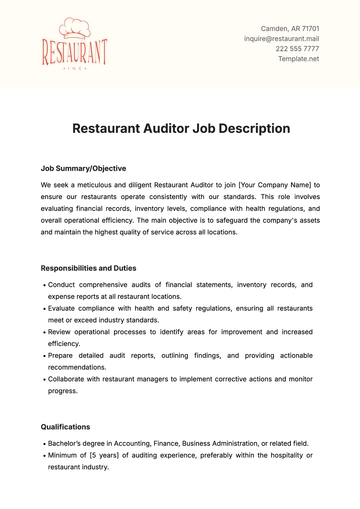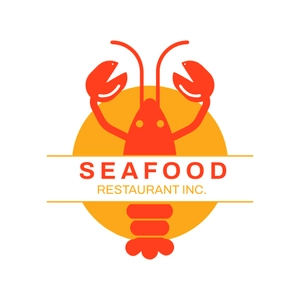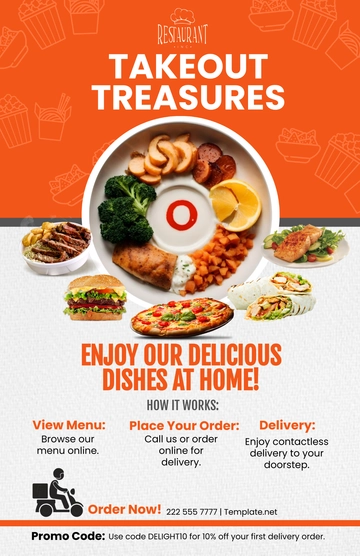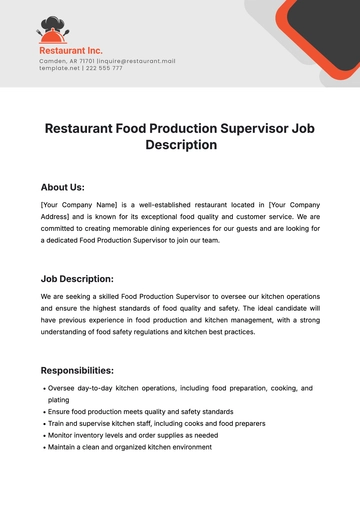Free Restaurant Staffing Guide

I. Introduction
A. Purpose and Scope
The purpose of this guide is to provide a comprehensive overview of the staffing requirements of the restaurant. It aims to ensure that all staff members are well-trained, competent, and capable of delivering excellent service to the customers. The following key areas will be covered:
Understanding the roles and responsibilities: Each staff member plays a crucial role in the restaurant’s operations. Understanding these roles and their responsibilities is the first step towards effective staffing.
Identifying the skills and qualifications: Different roles require different skills and qualifications. This guide will help identify what to look for when hiring for each position.
Implementing effective hiring and training processes: Hiring the right people is just the beginning. Implementing effective training processes is key to ensuring they can perform their roles effectively.
Ensuring compliance with health and safety regulations: Restaurants must comply with a variety of health and safety regulations. This guide will provide information on how to ensure the staff are trained to comply with these regulations.
Managing staff schedules and workloads: Effective scheduling is crucial to ensure the restaurant can deliver excellent service without overworking the staff. This guide will provide strategies for effective scheduling.
B. Target Audience
This guide is primarily intended for:
Restaurant Managers: Responsible for overseeing the overall operations of the restaurant, including staffing. This guide will provide the necessary tools and information to effectively manage the team.
Supervisors: Oversee specific areas of the restaurant and manage the staff within those areas. This guide will assist in understanding the role and responsibilities in more depth.
Owners: Involved in high-level decisions about the restaurant, including staffing strategies. This guide will provide valuable insights and strategies for effective staffing.
II. Roles and Responsibilities
In a restaurant setting, each role has its unique responsibilities that contribute to the overall operation and success of the business. Understanding these roles and their responsibilities is crucial for effective staffing and management. The following table provides an overview of the roles and responsibilities:
Role | Key Responsibilities |
|---|---|
Restaurant Manager | Overseeing overall operations, managing staff, ensuring excellent customer service. |
Chef | Preparing meals, managing kitchen staff, planning the menu, managing kitchen inventory |
Server | Taking orders, serving meals, ensuring a positive dining experience, cleaning tables, processing payments |
Bartender | Preparing and serving drinks, managing bar inventory, ensuring a positive customer experience at the bar. |
A. Restaurant Manager
The Restaurant Manager oversees the overall operations of the restaurant. This includes:
Staff Management: The Restaurant Manager is responsible for hiring, training, and managing the restaurant staff. They ensure that all staff members are performing their roles effectively and efficiently.
Customer Service: Ensuring excellent customer service is a key responsibility of the Restaurant Manager. They handle customer complaints and ensure that all customers have a positive dining experience.
Financial Management: The Restaurant Manager oversees the restaurant’s finances, including budgeting, cost control, and financial reporting.
Operations Management: They are responsible for managing the day-to-day operations of the restaurant, including food preparation, service, and cleanliness.
Compliance: The Restaurant Manager ensures that the restaurant complies with all relevant laws and regulations, including health and safety regulations.
B. Chef
The Chef is responsible for preparing meals and managing the kitchen staff. This includes:
Meal Preparation: The Chef is responsible for preparing meals according to the restaurant’s menu and recipes.
Menu Planning: They play a key role in planning the menu, taking into account factors such as customer preferences, food trends, and cost.
Kitchen Management: The Chef manages the kitchen staff, ensuring that they work efficiently and maintain high standards of food safety and hygiene.
Inventory Management: They are responsible for managing the kitchen inventory, ensuring that the kitchen is always stocked with the necessary ingredients.
C. Server
The Server interacts directly with customers, taking orders, serving meals, and ensuring a positive dining experience. This includes:
Taking Orders: The Server takes customers’ orders accurately and communicates them to the kitchen staff.
Serving Meals: They are responsible for serving meals in a timely and professional manner.
Customer Service: The Server plays a key role in ensuring a positive dining experience for customers. They respond to customer inquiries, handle complaints, and provide recommendations when asked.
Cleaning: They are also responsible for cleaning tables and other areas of the restaurant as needed.
Payment Processing: The Server processes customer payments, ensuring accuracy and efficiency.
D. Bartender
The Bartender prepares and serves drinks to customers. This includes:
Drink Preparation: The Bartender prepares drinks according to the restaurant’s menu and recipes.
Customer Service: They interact with customers, taking their orders and ensuring they have a positive experience at the bar.
Inventory Management: The Bartender manages the bar inventory, ensuring that the bar is always stocked with the necessary supplies.
Cleaning: They are responsible for keeping the bar area clean and organized.
Payment Processing: The Bartender processes customer payments for drinks.
Compliance: They ensure compliance with all relevant laws and regulations, including those related to serving alcohol.
These roles are crucial for the smooth operation of the restaurant. Each role has its unique responsibilities that contribute to the overall success of the business. Understanding these roles and their responsibilities is key for effective staffing and management. It ensures that all tasks are covered and that each staff member knows what is expected of them. This not only helps to ensure efficient operations but also contributes to a positive work environment where each staff member feels valued and part of the team.
Moreover, clearly defined roles and responsibilities are also important for effective staff management. They provide a basis for performance evaluations, training and development programs, and career progression pathways. This can help to increase job satisfaction and retention among staff.
Finally, understanding the roles and responsibilities of each staff member can also help in the recruitment process. It can help to identify the skills and qualifications needed for each role, and to create effective job descriptions and advertisements. This can help to attract the right candidates for each role, contributing to the overall success of the restaurant.
III. Staffing Strategy
Effective staffing is crucial to the success of any restaurant. It ensures that the restaurant operates smoothly and customers receive the best possible service. The following table outlines the key steps in our staffing strategy:
Step | Description |
|---|---|
1 | Identify staffing needs |
2 | Create job descriptions |
3 | Advertise job openings |
4 | Interview candidates |
5 | Select and hire staff |
6 | Train new hires |
7 | Schedule staff |
8 | Manage staff performance |
A. Identifying Staffing Needs
Identifying the staffing needs is the first step in the staffing process. It involves determining the number and types of employees needed to run the restaurant effectively. This includes:
Assessing the restaurant’s needs: Consider the size of the restaurant, the number of customers it serves, and the level of service it aims to provide.
Determining the roles needed: Identify the roles needed in the restaurant, such as chefs, servers, and managers.
Estimating the number of employees needed: Estimate the number of employees needed for each role, considering factors like peak hours and days off.
B. Creating Job Descriptions
Creating clear and comprehensive job descriptions is crucial for attracting the right candidates. It helps potential employees understand what is expected of them in the role. This includes:
Listing the duties and responsibilities: Clearly outline the tasks the employee will be expected to perform.
Specifying the skills and qualifications needed: List the skills and qualifications needed for the role, such as culinary skills for a chef or customer service skills for a server.
Describing the working conditions: Describe the working conditions, such as the hours and physical demands of the job.
Stating the compensation and benefits: State the salary range and any benefits, such as meals or health insurance.
C. Advertising Job Openings
Advertising job openings effectively is crucial for attracting a large pool of qualified candidates. It involves choosing the right platforms and crafting compelling job ads. This includes:
Choosing the right platforms: Consider where potential candidates are likely to look for jobs, such as job boards, social media, or the restaurant’s website.
Crafting compelling job ads: Write job ads that clearly describe the role and its requirements, and highlight the benefits of working at the restaurant.
Promoting the job openings: Promote the job openings through various channels, such as social media, email newsletters, or word of mouth.
Responding to inquiries: Respond to any inquiries about the job openings in a timely and professional manner.
Screening applications: Review the applications received and screen them based on the requirements of the role.
D. Interviewing Candidates
Interviewing candidates allows the restaurant to assess their suitability for the role. It involves preparing for the interview, conducting the interview, and evaluating the candidate. This includes:
Preparing for the interview: Prepare a list of questions to ask the candidate, focusing on their skills, experience, and fit for the role.
Conducting the interview: Conduct the interview in a professional and respectful manner, giving the candidate a chance to ask their own questions.
Evaluating the candidate: Evaluate the candidate based on their responses, their demeanor during the interview, and their potential fit for the role.
Following up with the candidate: Follow up with the candidate after the interview, either to offer them the job, reject them, or invite them for a second interview.
Checking references: If the candidate is a strong contender for the role, check their references to confirm their skills and experience.
E. Selecting and Hiring Staff
Selecting and hiring the right staff is crucial for the success of the restaurant. It involves making a job offer, negotiating the terms of employment, and onboarding the new hire. This includes:
Making a job offer: Once a suitable candidate has been identified, extend a job offer outlining the terms of employment, including the role, responsibilities, salary, and benefits.
Negotiating the terms of employment: Be prepared to negotiate the terms of employment, such as salary and work hours, to ensure both the restaurant and the new hire are satisfied.
Onboarding the new hire: Once the job offer has been accepted, conduct an onboarding process to familiarize the new hire with the restaurant’s operations, culture, and expectations.
Setting up payroll and benefits: Ensure the new hire is set up on the restaurant’s payroll system and enrolled in any applicable benefits programs.
Communicating with the team: Introduce the new hire to the rest of the team to foster a welcoming and inclusive work environment.
Having the right people in the right roles allows the restaurant to operate efficiently and provide high-quality service. Each role, from the chefs in the kitchen to the servers on the floor, plays a crucial part in the overall customer experience. Therefore, it’s essential to hire individuals who have the skills, experience, and attitude necessary to excel in their roles.
Additionally, effective staffing also involves providing ongoing training and development opportunities for staff. This not only equips them with the skills they need to perform their roles effectively but also helps to increase job satisfaction and retention. Investing in staff development is a win-win situation - the restaurant benefits from having skilled and motivated staff, and the staff benefit from having opportunities to learn and grow in their careers.
Lastly, effective staffing also involves creating a positive work environment where staff feel valued and appreciated. This includes treating staff with respect, recognizing their contributions, and providing them with the support they need to succeed. A positive work environment can help to boost staff morale, productivity, and retention.
IV. Training and Development
Training and development are crucial aspects of restaurant staffing. They ensure that all staff members have the skills and knowledge they need to perform their roles effectively and provide excellent service to customers.
A. New Hire Training
New hire training is designed to equip new staff members with the skills and knowledge they need to perform their roles effectively. This includes:
Orientation: New hires should undergo an orientation program to familiarize themselves with the restaurant’s operations, culture, and expectations. This should be conducted within the first week of employment.
Role-Specific Training: Each new hire should receive training specific to their role. This should cover the tasks they will be performing, the skills they will need, and the standards they are expected to meet. This training should be conducted within the first two weeks of employment.
Health and Safety Training: All new hires should receive training on health and safety regulations relevant to their role. This should include food safety, fire safety, and first aid training. This training should be conducted within the first month of employment.
Customer Service Training: New hires should receive training on how to provide excellent customer service. This should cover communication skills, handling customer complaints, and promoting a positive dining experience. This training should be conducted within the first month of employment.
Ongoing Training: After the initial training period, new hires should receive ongoing training to further develop their skills and knowledge. This could include regular workshops, online courses, or on-the-job training. This training should be conducted on a monthly basis.
B. Ongoing Staff Development
Ongoing staff development is designed to help existing staff members continue to grow and develop in their roles. This includes:
Skill Development: Staff members should have opportunities to develop new skills and improve existing ones. This could include training in new cooking techniques for chefs, or advanced customer service skills for servers. This training should be conducted on a quarterly basis.
Career Development: Staff members should have opportunities to progress in their careers. This could include leadership training for those aspiring to become supervisors or managers. This training should be conducted on a bi-annual basis.
Performance Reviews: Regular performance reviews can help staff members understand their strengths and areas for improvement. This can inform future training and development activities. Performance reviews should be conducted on an annual basis.
Recognition and Rewards: Recognizing and rewarding staff for their hard work and achievements can boost morale and motivation. This could include employee of the month awards, bonuses, or special events. Recognition and rewards should be given on a monthly basis.
C. Leadership Training
Leadership training is designed to equip supervisors and managers with the skills they need to lead their teams effectively. This includes:
Leadership Skills: Supervisors and managers should receive training on key leadership skills, such as communication, decision-making, and problem-solving. This training should be conducted on a quarterly basis.
Team Management: Supervisors and managers should receive training on how to manage a team effectively. This should include topics such as delegation, conflict resolution, and performance management. This training should be conducted on a bi-annual basis.
Strategic Planning: Supervisors and managers should receive training on strategic planning. This should include topics such as setting goals, planning resources, and monitoring progress. This training should be conducted on an annual basis.
Change Management: Supervisors and managers should receive training on how to manage change effectively. This could include topics such as leading through change, managing resistance to change, and communicating change. This training should be conducted on an annual basis.
Ongoing Development: Supervisors and managers should have opportunities for ongoing development. This could include advanced leadership training, mentoring, or coaching. This training should be conducted on a monthly basis.
V. Retention and Staff Management
Effective staff management and retention are crucial for the success of the restaurant. They ensure that the restaurant has a stable, skilled, and motivated workforce that can deliver excellent service to customers.
A. Staff Retention
Staff retention involves implementing strategies to keep staff satisfied and motivated, reducing turnover and ensuring continuity in service. This includes:
Competitive Compensation: Offering competitive salaries and benefits can help to attract and retain high-quality staff. This should be reviewed annually to ensure competitiveness.
Recognition and Rewards: Recognizing and rewarding staff for their hard work and achievements can boost morale and motivation. This could include employee of the month awards, bonuses, or special events. Recognition and rewards should be given on a monthly basis.
Career Development Opportunities: Providing opportunities for career development can help to increase job satisfaction and retention. This could include training, mentoring, or opportunities for promotion. Career development opportunities should be provided on a quarterly basis.
Positive Work Environment: Creating a positive work environment where staff feel valued and appreciated can help to boost morale and retention. This includes treating staff with respect, promoting teamwork, and maintaining a clean and safe workplace. Efforts to maintain a positive work environment should be ongoing.
Work-Life Balance: Respecting staff’s work-life balance can help to reduce burnout and increase retention. This includes providing flexible schedules, reasonable work hours, and time off. Work-life balance considerations should be reviewed on a monthly basis.
B. Staff Management
Staff management involves overseeing staff performance, resolving conflicts, and ensuring a harmonious workplace. This includes:
Performance Management: Regular performance reviews can help staff members understand their strengths and areas for improvement. This can inform future training and development activities. Performance reviews should be conducted on an annual basis.
Conflict Resolution: Effective conflict resolution can help to maintain a harmonious workplace. This includes providing training on conflict resolution skills, and intervening in conflicts when necessary. Conflict resolution strategies should be reviewed and updated on a quarterly basis.
Communication: Open and effective communication is key to good staff management. This includes regular staff meetings, one-on-one check-ins, and clear and timely communication about changes or issues. Communication strategies should be reviewed and updated on a monthly basis.
Team Building: Regular team building activities can help to build trust, improve communication, and increase collaboration among staff. This could include team outings, team building exercises, or social events. Team building activities should be conducted on a bi-annual basis.
C. Staff Scheduling
Effective staff scheduling ensures that the restaurant has enough staff to provide excellent service, while also considering staff’s work-life balance. This includes:
Forecasting Staffing Needs: Accurately forecasting staffing needs can help to ensure that the restaurant has enough staff to meet demand. This should take into account factors such as peak times, special events, and staff absences. Staffing needs should be forecasted on a weekly basis.
Creating Schedules: Creating fair and balanced schedules can help to ensure that all shifts are covered, while also considering staff’s preferences and work-life balance. Schedules should be created on a weekly basis.
Managing Time Off Requests: Effectively managing time off requests can help to ensure that staff are able to take time off when they need it, while also ensuring that the restaurant is adequately staffed. Time off requests should be managed on an ongoing basis.
Adjusting Schedules as Needed: Adjusting schedules as needed can help to address unexpected changes or issues, such as staff absences or unexpected increases in demand. Schedule adjustments should be made as needed.
Communicating Schedules: Communicating schedules to staff in a clear and timely manner can help to ensure that all staff know when they are expected to work. Schedules should be communicated to staff as soon as they are created.
VI. Frequently Asked Questions (FAQs)
Q: How often should training and development programs be conducted?
A: Training and development programs should be conducted on a regular basis to ensure that all staff members have the skills and knowledge they need to perform their roles effectively. The frequency can vary depending on the specific training program and the needs of the restaurant.Q: What strategies can be used to retain staff?
A: Strategies for staff retention can include offering competitive compensation, recognizing and rewarding staff for their hard work, providing career development opportunities, creating a positive work environment, and respecting staff’s work-life balance.Q: How can conflicts in the workplace be resolved?
A: Conflicts in the workplace can be resolved through effective communication, understanding, and compromise. Training on conflict resolution skills can also be beneficial.Q: What is the importance of staff scheduling?
A: Effective staff scheduling ensures that the restaurant has enough staff to provide excellent service, while also considering staff’s work-life balance. It involves forecasting staffing needs, creating schedules, managing time off requests, adjusting schedules as needed, and communicating schedules to staff.Q: How can performance be managed effectively?
A: Effective performance management involves regular performance reviews, which can help staff members understand their strengths and areas for improvement. It also involves providing feedback and recognition, setting performance goals, and providing support and training as needed.Q: What is the role of a Restaurant Manager?
A: The Restaurant Manager oversees the overall operations of the restaurant, including staff management, customer service, financial management, operations management, and compliance with regulations.
- 100% Customizable, free editor
- Access 1 Million+ Templates, photo’s & graphics
- Download or share as a template
- Click and replace photos, graphics, text, backgrounds
- Resize, crop, AI write & more
- Access advanced editor
Ensure efficient staffing processes with the Restaurant Staffing Guide Template available on Template.net! This resource offers an editable means to define staffing requirements and procedures. Utilize the customizable features to tailor the guide to your restaurant's staffing needs. With the assistance of the AI Editor Tool, optimize staffing decisions now!
You may also like
- Restaurant Agreement
- Restaurant Banner
- Sheet
- Restaurant Checklist
- Restaurant Form
- Restaurant Invitation
- Restaurant Invoice
- Restaurant Letterhead
- Restaurant Meeting Minute
- Restaurant Menu
- Restaurant Presentation
- Restaurant Policy
- Restaurant Proposal
- Restaurant Receipt
- Restaurant Report
- Restaurant Spreadsheet
- Restaurant Flyer
- Restaurant Plan
- Restaurant Poster
- Restaurant Contract
- Restaurant Business Card
- Restaurant Schedule
- Restaurant Brochure
- Restaurant Survey
- Restaurant Evaluation
- Restaurant Business Plan


